Among all modern celebrations throughout the year, Easter is one of the most ancient. It began as a Jewish tradition which turned into a Christian one and finally a secular one. Its diversity has led to many interesting celebrations. In the Jewish tradition, Passover celebrates the freedom of the Israelites from Egyptian slavery around 1450 BC.
It is named Passover because the enslaved Jews were to mark their doors with the blood of a lamb so that God would pass over them and not kill their first-born son. For Christians, Jesus Christ died on the Passover. After three days, Jesus resurrected which showed that he conquered death and sin. By his sacrifice, every person who believes in him will be freed from sin and death. This monumental event in Christianity is celebrated as Easter.
The transition from Passover to Easter was a long process. Early Christians celebrated Easter much like Jews had been celebrating Passover. There was even a big debate on whether to rely on the Jewish calendar for the date or create an independent way to figure out the date. As Christianity developed, Easter became more distinct.
In the end, Christians decided to create their own calendar. However, as time went on, even the new calendar became fractured. Now, Western Christianity celebrates Easter on a different date than Eastern Christianity.
In most other languages, Easter is better translated as “Passover”. But, in English, the name Easter comes from St. Bede, an 8th c. English monk who studied history. He wrote that Easter derived its name from the pagan festival of Easter, which celebrated the Anglo-Saxon goddess of spring, Eostre.
It was celebrated around the same time as Easter, and so, early Christians replaced Eostre with Easter. The name stuck through the influence of St. Bede. It literally means “dawn” or “east, toward the sunrise”.
In modern times, Easter has gone a secular transition as can be seen in the Easter eggs and the Easter Bunny. Originally, the Easter egg was a pagan symbol of new life. Christians adopted the egg as a symbol of Jesus’ resurrection and our new life. The empty egg is a symbol of the empty tomb Jesus was buried in. Today, the Easter egg is filled with candy.
Similarly, the Easter Bunny was a pagan symbol of Spring and new life since rabbits reproduce prodigiously. Christians adopted it as a judge who determined which children were good or bad during the Easter season. In Australia, the Easter Bilby is becoming a popular alternative to the bunny since they are pests there.
The long history of Easter and its interesting combination of cultures and traditions make it one of the unique holidays we still celebrate. Despite the many differences, life and people are at the heart of this celebration.


















